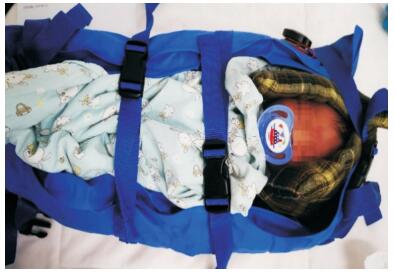 PDF(1765 KB)
PDF(1765 KB)


Application of vacuum stretcher combined with feeding in cranial magnetic resonance imaging examination for neonates: a prospective randomized controlled study
SHEN Xiao-Xia, LIU Ting-Ting, GAO Fu-Sheng, WU Dan, DU Li-Zhong, MA Xiao-Lu
Chinese Journal of Contemporary Pediatrics ›› 2020, Vol. 22 ›› Issue (5) : 435-440.
 PDF(1765 KB)
PDF(1765 KB)
 PDF(1765 KB)
PDF(1765 KB)
Application of vacuum stretcher combined with feeding in cranial magnetic resonance imaging examination for neonates: a prospective randomized controlled study
Objective To study the effect and safety of vacuum stretcher combined with feeding in cranial magnetic resonance imaging (MRI) examination for neonates. Methods A prospective study was performed for the neonates with hyperbilirubinemia, with a gestational age of > 34 weeks and stable vital signs, who needed cranial MRI examination and did not need oxygen inhalation hospitalized in the Department of Neonatology, Children's Hospital of Zhejiang University School of Medicine, from September to November, 2019. The neonates were randomly divided into a vacuum stretcher combined with feeding group and a conventional sedation group. Vital signs were monitored before, during, and after MRI examination. The success rate of MRI procedure was recorded. Results A total of 80 neonates were enrolled in the study, with 40 neonates in the vacuum stretcher combined with feeding group and 40 in the conventional sedation group. The vacuum stretcher combined with feeding group had a significantly higher success rate of MRI procedure than the conventional sedation group (P < 0.05). As for the neonates who underwent successful MRI examination, the fastest heart rate after examination in the vacuum stretcher combined with feeding group was significantly lower than that in the conventional sedation group (P < 0.05), while there were no significant differences between the two groups in transcutaneous oxygen saturation, respiratory rate, and body temperature before and after MRI examination (P > 0.05). No complications, such as apnea, acute allergic reactions, and malignant fever, were observed. Conclusions Vacuum stretcher combined with feeding can improve the success rate of MRI procedure and reduce the use of sedatives, and meanwhile, it does not increase related risks.

Magnetic resonance imaging / Sedative / Vacuum stretcher / Feeding / Neonate
[1] Jaimes C, Gee MS. Strategies to minimize sedation in pediatric body magnetic resonance imaging[J]. Pediatr Radiol, 2016, 46(6):916-927.
[2] Kang R, Shin YH, Gil NS, et al. A comparison of the use of propofol alone and propofol with midazolam for pediatric magnetic resonance imaging sedation-a retrospective cohort study[J]. BMC Anesthesiol, 2017, 17(1):138.
[3] Barton K, Nickerson JP, Higgins T, et al. Pediatric anesthesia and neurotoxicity:what the radiologist needs to know[J]. Pediatr Radiol, 2018, 48(1):31-36.
[4] Bjur KA, Payne ET, Nemergut ME, et al. Anesthetic-related neurotoxicity and neuroimaging in children:a call for caonversation[J]. J Child Neurol, 2017, 32(6):594-602.
[5] Parad RB. Non-sedation of the neonate for radiologic procedures[J]. Pediatr Radiol, 2018, 48(4):524-530.
[6] Shariat M, Mertens L, Seed M, et al. Utility of feed-and-sleep cardiovascular magnetic resonance in young infants with complex cardiovascular disease[J]. Pediatr Cardiol, 2015, 36(4):809-812.
[7] Shariat M, Mertens L, Seed M, et al. Utility of feed-and-sleep cardiovascular magnetic resonance in young infants with complex cardiovascular disease[J]. Pediatr Cardiol, 2015, 36(4):809-812.
[8] Ahmad R, Hu HH, Krishnamurthy R, et al. Reducing sedation for pediatric body MRI using accelerated and abbreviated imaging protocols[J]. Pediatr Radiol, 2018, 48(1):37-49.
[9] Kannikeswaran N, Mahajan PV, Sethuraman U, et al. Sedation medication received and adverse events related to sedation for brain MRI in children with and without developmental disabilities[J]. Paediatr Anaesth, 2009, 19(3):250-256.
[10] Jaimes C, Murcia DJ, Miguel K, et al. Identification of quality improvement areas in pediatric MRI from analysis of patient safety reports[J]. Pediatr Radiol, 2018, 48(1):66-73.
[11] Khawaja AA, Tumin D, Beltran RJ, et al. Incidence and causes of adverse events in diagnostic radiological studies requiring anesthesia in the Wake-Up Safe registry[J]. J Patient Saf, 2018. DOI:10.1097/PTS.0000000000000469. Epub ahead of print.
[12] Antonov NK, Ruzal-Shapiro CB, Morel KD, et al. Feed and wrap MRI technique in infants[J]. Clin Pediatr (Phila), 2017, 56(12):1095-1103.
[13] Ibrahim T, Few K, Greenwood R, et al. ‘Feed and wrap’ or sedate and immobilise for neonatal brain MRI?[J]. Arch Dis Child Fetal Neonatal Ed, 2015, 100(5):F465-F466.
[14] Kini K, Kini PG. Sleep deprivation for radiological procedures in children[J]. Pediatr Radiol, 2009, 39(11):1255.
[15] Nelson AM. Risks and benefits of swaddling healthy infants:an integrative review[J]. MCN Am J Matern Child Nurs, 2017, 42(4):216-225.
[16] van Sleuwen BE, Engelberts AC, Boere-Boonekamp MM, et al. Swaddling:a systematic review[J]. Pediatrics, 2007, 120(4):e1097-e1106.
[17] Edwards AD, Arthurs OJ. Paediatric MRI under sedation:is it necessary? What is the evidence for the alternatives?[J]. Pediatr Radiol, 2011, 41(11):1353-1364.
[18] Mahan ST, Kasser JR. Does swaddling influence developmental dysplasia of the hip?[J]. Pediatrics, 2008, 121(1):177-178.
[19] Linder JMB. Safety considerations in immobilizing pediatric clients for radiographic procedures[J]. J Radiol Nurs, 2017, 36(1):55-58.